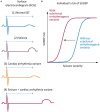Are Variants Causing Cardiac Arrhythmia Risk Factors in Sudden Unexpected Death in Epilepsy?
- PMID: 33013630
- PMCID: PMC7505992
- DOI: 10.3389/fneur.2020.00925
Are Variants Causing Cardiac Arrhythmia Risk Factors in Sudden Unexpected Death in Epilepsy?
Abstract
Sudden unexpected death in epilepsy (SUDEP) is the most common cause of premature mortality in individuals with epilepsy. Acute and adaptive changes in heart rhythm in epilepsy implicate cardiac dysfunction as a potential pathogenic mechanism in SUDEP. Furthermore, variants in genes associated with Long QT syndrome (LQTS) have been identified in patients with SUDEP. LQTS is a cardiac arrhythmia condition that causes sudden cardiac death with strong similarities to SUDEP. Here, we discuss the possibility of an additive risk of death due to the functional consequences of a pathogenic variant in an LQTS gene interacting with seizure-mediated changes in cardiac function. Extending this general concept, we propose a hypothesis that common variants in LQTS genes, which cause a subtle impact on channel function and would not normally be considered risk factors for cardiac disease, may increase the risk of sudden death when combined with epilepsy. A greater understanding of the interaction between epilepsy, cardiac arrhythmia, and SUDEP will inform our understanding of SUDEP risk and subsequent potential prophylactic treatment.
Keywords: cardiac arrhythmia; common variants; epilepsy; genetics; ion channels; sudden unexpected death in epilepsy.
Copyright © 2020 Bleakley, Soh, Bagnall, Sadleir, Gooley, Semsarian, Scheffer, Berkovic and Reid.
Figures

Similar articles
-
Exome-based analysis of cardiac arrhythmia, respiratory control, and epilepsy genes in sudden unexpected death in epilepsy.Ann Neurol. 2016 Apr;79(4):522-34. doi: 10.1002/ana.24596. Epub 2016 Feb 2. Ann Neurol. 2016. PMID: 26704558
-
Systematic Review of the Genetics of Sudden Unexpected Death in Epilepsy: Potential Overlap With Sudden Cardiac Death and Arrhythmia-Related Genes.J Am Heart Assoc. 2020 Jan 7;9(1):e012264. doi: 10.1161/JAHA.119.012264. Epub 2019 Dec 21. J Am Heart Assoc. 2020. PMID: 31865891 Free PMC article.
-
Rare sudden unexpected death in epilepsy SCN5A variants cause changes in channel function implicating cardiac arrhythmia as a cause of death.Epilepsia. 2022 Jun;63(6):e57-e62. doi: 10.1111/epi.17254. Epub 2022 Apr 22. Epilepsia. 2022. PMID: 35397174
-
Cardiac arrhythmia and epilepsy genetic variants in sudden unexpected death in epilepsy.Front Neurol. 2024 May 2;15:1386730. doi: 10.3389/fneur.2024.1386730. eCollection 2024. Front Neurol. 2024. PMID: 38756210 Free PMC article.
-
Clinical pharmacology: drugs as a benefit and/or risk in sudden unexpected death in epilepsy?J Clin Pharmacol. 2002 Feb;42(2):123-36. doi: 10.1177/00912700222011157. J Clin Pharmacol. 2002. PMID: 11831534 Review.
Cited by
-
The mechanism of sudden unexpected death in epilepsy: A mini review.Front Neurol. 2023 Feb 6;14:1137182. doi: 10.3389/fneur.2023.1137182. eCollection 2023. Front Neurol. 2023. PMID: 36815002 Free PMC article. Review.
-
Sudden unexpected death in epilepsy: A critical view of the literature.Epilepsia Open. 2023 Sep;8(3):728-757. doi: 10.1002/epi4.12722. Epub 2023 May 17. Epilepsia Open. 2023. PMID: 36896633 Free PMC article. Review.
-
Aborted sudden cardiac death in a young patient with epilepsy and the Gorlin Goltz syndrome.Epilepsy Behav Rep. 2024 Apr 18;26:100667. doi: 10.1016/j.ebr.2024.100667. eCollection 2024. Epilepsy Behav Rep. 2024. PMID: 38699063 Free PMC article.
-
Cardiac Investigations in Sudden Unexpected Death in DEPDC5-Related Epilepsy.Ann Neurol. 2022 Jan;91(1):101-116. doi: 10.1002/ana.26256. Epub 2021 Nov 16. Ann Neurol. 2022. PMID: 34693554 Free PMC article.
-
Ion channel traffic jams: the significance of trafficking deficiency in long QT syndrome.Cell Discov. 2025 Jan 10;11(1):3. doi: 10.1038/s41421-024-00738-0. Cell Discov. 2025. PMID: 39788950 Free PMC article. Review.
References
-
- Thurman DJ, Logroscino G, Beghi E, Hauser WA, Hesdorffer DC, Newton CR, et al. . The burden of premature mortality of epilepsy in high-income countries: a systematic review from the Mortality Task Force of the International League Against Epilepsy. Epilepsia. (2017) 58:17–26. 10.1111/epi.13604 - DOI - PMC - PubMed
LinkOut - more resources
Full Text Sources

